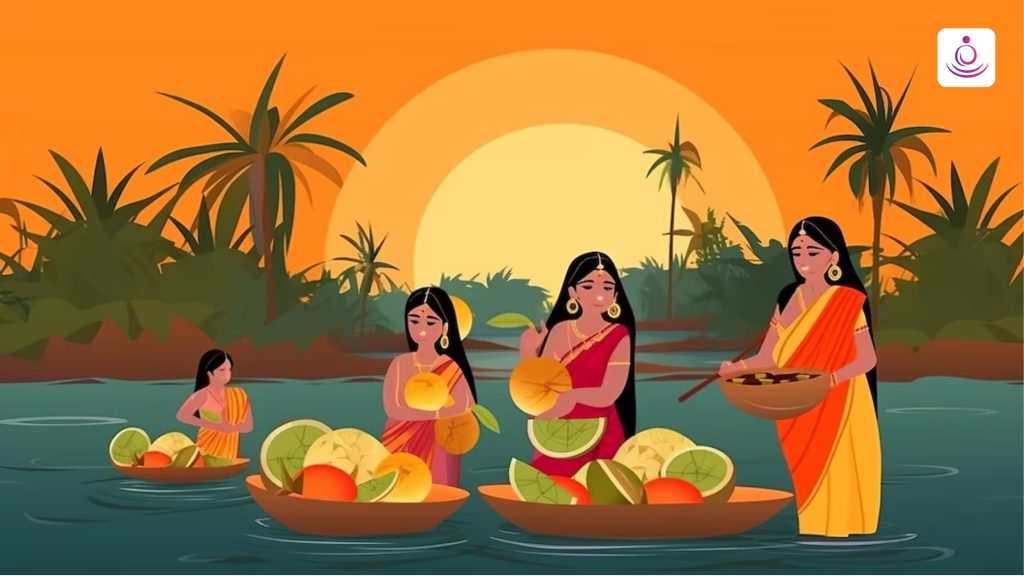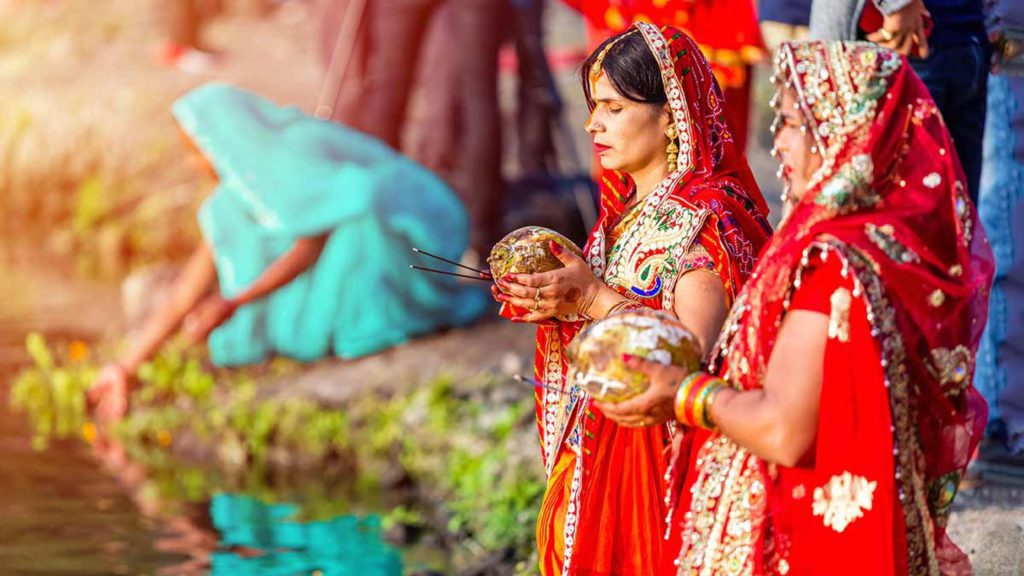The Do’s and Don’ts of Chhath Puja 2023, Health benefits, & its Significance
Let us understand the Do’s and Don’ts of Chhath Puja 2023. You'll also know the spiritual and health benefits of Chhath Puja, based on scientific theories.

Chhath Puja, also known as Dala Chhath or Surya Shashthi, is observed in the Kartik month, falling in October and November, shortly after Deepavali. While Chhath is celebrated twice a year, Kartik Chhath is the most significant.
The guidelines for Chhath Puja are stringent, emphasising the festival’s sanctity. People diligently maintain the purity of this occasion during Prasad preparation and Arghya offerings.
Virtual Puja Experience,
Anytime, Anywhere.
Book Your Puja Now & Ensure A Spiritual Experience For You & Your Loved Ones.
Let us understand some of these protocols to be followed, along with those that we need to refrain from. Further down, we will also discuss the spiritual and health benefits of Chhath Puja, backed by scientific basis.
Do’s:
1.To kick off the preparations for Chhath Puja, people commence the process right after Deepavali. They assist the Vratti (the woman observing the fast) in washing and drying the wheat, which will be used for making Prasad later.
2. Ensure daily bathing and cleanliness before engaging in any Chhath Puja activities.
3. After washing your hands, handle the items used in the puja.
4. Prior to Prasad preparation, maintain thorough hand and foot hygiene.
5. On Chhath Puja day at Sandhya Ghat and Bhorwa Ghat, take a bath, don new clothes, and gather with family and friends at the riverbanks.
6. Offer reverence to the Sun God and seek blessings from elders.
Don’ts:
1. Avoid touching any puja items without washing hands or bathing.
2. Refrain from consuming or handling salty items during Prasad preparation, as it is strictly forbidden.
3. If a family member is observing Chhath Puja, abstain from non-vegetarian food at home.
4. Prevent children from consuming puja fruits and Prasad until the festival concludes.
5. Maintain the cleanliness and order of puja materials.
6. Adorn clean, new clothing during the puja and refrain from drinking or smoking, as it is strictly prohibited during the ceremony.
Chhath Puja is believed to bring prosperity and good health when conducted with utmost purity and reverence.

Spiritual and Scientific Significance of Chhath Puja: A Yogic Perspective
- According to yogic philosophy, the physical forms of all living beings serve as advanced energy channels. When exposed to specific wavelengths of solar radiation, the human body begins to absorb solar bio-electricity. Under specific physical and mental conditions, the absorption and conduction of this solar bio-electricity intensifies.
- The Chhath Puja rituals are designed to prepare the devotee’s body and mind for the infusion of cosmic solar energy.
- In ancient times, sages employed a similar process to what is observed during Chhath Puja, refraining from solid or liquid diets. Through this process, they absorbed life-sustaining energy directly from the sun, bypassing the need for food and water.
- The retina functions as a photoelectric substance emitting energy when exposed to light. Consequently, subtle energy emanates from the retina, which is then transferred from the retina to the pineal gland through the optic nerves, activating it.
- The pineal gland, along with the hypothalamus and pituitary glands (referred to as Triveni), is located nearby. Consequently, the energy generated in this process also affects these glands. As a result, pranic activity becomes regular, providing the devotee with a peaceful mind and a healthy body.

Phases of Chhath (Conscious Photo Energization Process): Awakening the Higher Consciousness
According to Yogic Philosophy, the Chhath Puja process consists of six stages of the Conscious Cosmic Solar Energy Infusion Technique:
- 1st Stage: Fasting and maintaining cleanliness lead to the complete detoxification of the mind, body, and soul. This stage allows the Vratti’s mind and body to access cosmic solar energy.
- 2nd Stage: This stage involves standing in a river or water body with half of the body submerged. It minimises energy loss and facilitates the flow of psychic energy (Prana) through the spinal channel (Sushumna).
- 3rd Stage: Cosmic solar energy enters the Vratti’s pituitary, pineal, and hypothalamus glands through the optic nerves and retina.
- 4th Stage: Activation of the Triveni or tri-glandular complex takes place in this stage.
- 5th Stage: A division occurs in the spine, transforming the Vratti’s body into a cosmic powerhouse and awakening latent psychic energy, often referred to as Kundalini Shakti.
- 6th Stage: During this stage, the devotee’s body becomes a conduit that recycles, conducts, and transmits energy throughout the universe.
Benefits of the Chhath Puja Process
- The Chhath Puja process is primarily focused on the mental discipline of the devotee, aiming to guide them toward mental purity, that is, purity of thoughts. Through various rituals, Chhath Vrattis emphasise maintaining the highest levels of cleanliness in all offerings and the environment, with cleanliness being a top priority during the festival.
- This emphasis on cleanliness results in a profound detoxification effect on the mind and body, leading to biochemical changes. The 36-hour fasting period allows for a complete detoxification of the body.
- Complete detoxification helps maintain the flow of Prana and enhances the devotee’s energy levels. The natural immune system expends a significant amount of energy combating toxins in the body. By reducing toxins through detoxification processes such as meditation, pranayama, yoga, and Chhath rituals, the body expends less energy, making the devotee feel more energetic. Additionally, it improves skin texture, enhances eyesight, and slows down the ageing process.
- Photo-Electro-Chemical Effect: Safe exposure to sunlight helps cure fungal and bacterial infections. As a result of Chhath Puja, the energy absorbed by the bloodstream enhances the function of white blood cells. Solar energy also balances hormone secretion and directly fulfils the body’s energy requirements, further detoxifying the body.
- Mental Health Benefits: Chhath Puja rituals contribute to inner calmness. Regularising the flow of Prana reduces negative emotions such as jealousy and anger. With patience and dedicated practice, psychic powers, including healing, intuition, and telepathic communication, are awakened, depending on the level of concentration practised by devotees during the festival.
Now that we’ve understood the immense benefits that celebrating this profound festival has, here’s a scientific fact for you all.
Did you know that why is it that we only perform the rituals at the time of sunrise or sunset?
Yes, there’s a list of reasons – both scientific and religious:
1. Lesser UV Radiation: During sunrise and sunset, the angle of the Sun’s rays is such that the amount of harmful ultraviolet (UV) radiation is reduced, making it safer for people to spend time outdoors without excessive exposure to UV rays. Hence, the majority of humans can safely receive solar energy. However, there may be some exceptions.
2. Vitamin D absorption: Sunlight is the best natural source of vitamin D, which is essential for the human body. During sunrise and sunset, the Sun’s rays are less intense and more conducive for the body to synthesise vitamin D. Exposing oneself to the Sun during these times can help in maintaining good health.
3. Cooler and Safer Temperatures: Sunrise and sunset are generally cooler times of the day compared to midday when the Sun is at its peak. This makes it more comfortable for devotees to perform rituals without the discomfort of excessive heat.
4. Connection with Environmental Beauty: The visual appeal of sunrise and sunset creates a serene and peaceful atmosphere, enhancing the spiritual experience and connection with nature.
So, this is why the festival Chhath Puja features a tradition of offering Arghya to the sun in late evening and early in the morning.
Besides, sunrise and sunset are the times when the Sun is closest to the horizon, and it is believed that it is an auspicious moment to connect with the divine energy of the Sun and seek its blessings for health, prosperity, and well-being.
Overall, conducting Chhath rituals during sunrise and sunset is not only in line with the religious significance of the Sun but also aligns with the natural and scientific benefits of these times of the day, promoting both physical and mental well-being.
Last Thoughts
In summary, Chhath Puja is spiritually significant as it connects devotees to the divine through the worship of the Sun God, promotes purification and self-discipline, underscores the importance of nature, and strengthens community bonds. It is a befitting identity of faith, deeply rooted in its cultural and religious heritage, and its observance helps maintain a sense of belonging and pride among the people of the region.

For more such interesting reads about Hindu festivals, rituals, and astrology, feel free to download the VAMA App.




